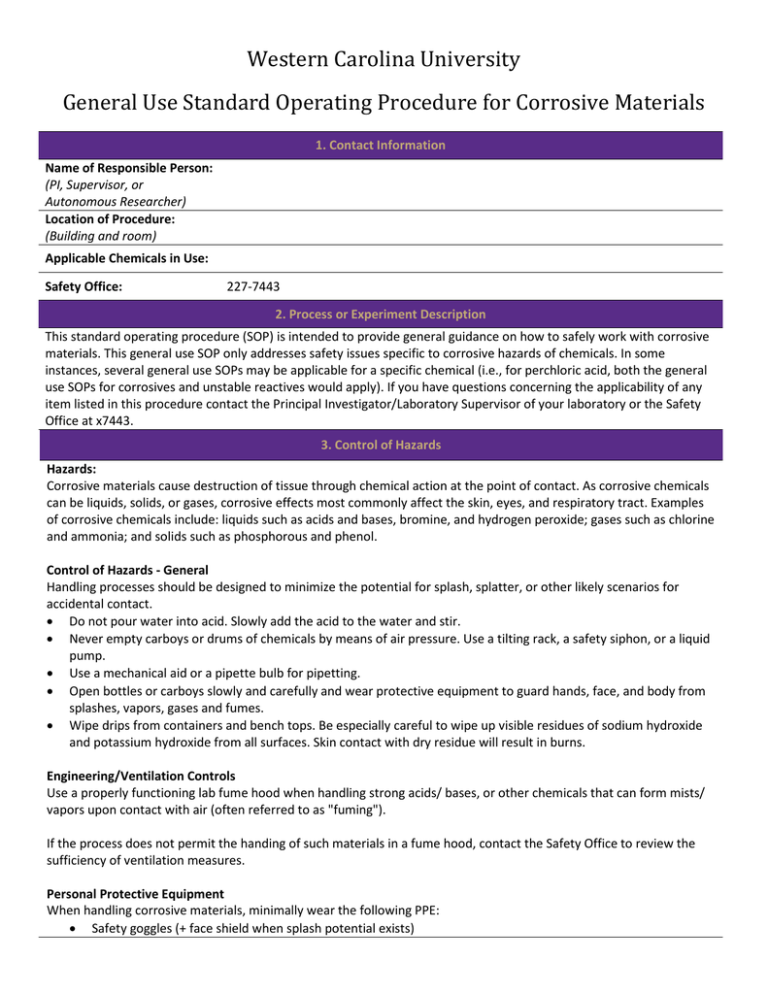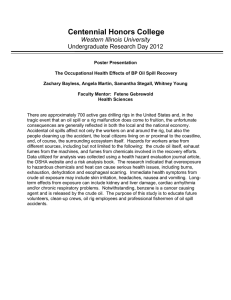Western Carolina University General Use Standard Operating Procedure for Corrosive Materials
advertisement

Western Carolina University General Use Standard Operating Procedure for Corrosive Materials 1. Contact Information Name of Responsible Person: (PI, Supervisor, or Autonomous Researcher) Location of Procedure: (Building and room) Applicable Chemicals in Use: Safety Office: 227-7443 2. Process or Experiment Description This standard operating procedure (SOP) is intended to provide general guidance on how to safely work with corrosive materials. This general use SOP only addresses safety issues specific to corrosive hazards of chemicals. In some instances, several general use SOPs may be applicable for a specific chemical (i.e., for perchloric acid, both the general use SOPs for corrosives and unstable reactives would apply). If you have questions concerning the applicability of any item listed in this procedure contact the Principal Investigator/Laboratory Supervisor of your laboratory or the Safety Office at x7443. 3. Control of Hazards Hazards: Corrosive materials cause destruction of tissue through chemical action at the point of contact. As corrosive chemicals can be liquids, solids, or gases, corrosive effects most commonly affect the skin, eyes, and respiratory tract. Examples of corrosive chemicals include: liquids such as acids and bases, bromine, and hydrogen peroxide; gases such as chlorine and ammonia; and solids such as phosphorous and phenol. Control of Hazards - General Handling processes should be designed to minimize the potential for splash, splatter, or other likely scenarios for accidental contact. • Do not pour water into acid. Slowly add the acid to the water and stir. • Never empty carboys or drums of chemicals by means of air pressure. Use a tilting rack, a safety siphon, or a liquid pump. • Use a mechanical aid or a pipette bulb for pipetting. • Open bottles or carboys slowly and carefully and wear protective equipment to guard hands, face, and body from splashes, vapors, gases and fumes. • Wipe drips from containers and bench tops. Be especially careful to wipe up visible residues of sodium hydroxide and potassium hydroxide from all surfaces. Skin contact with dry residue will result in burns. Engineering/Ventilation Controls Use a properly functioning lab fume hood when handling strong acids/ bases, or other chemicals that can form mists/ vapors upon contact with air (often referred to as "fuming"). If the process does not permit the handing of such materials in a fume hood, contact the Safety Office to review the sufficiency of ventilation measures. Personal Protective Equipment When handling corrosive materials, minimally wear the following PPE: • Safety goggles (+ face shield when splash potential exists) • • • • Laboratory coat (+ apron and/or over sleeves to match the chemical where contact with body or skin is foreseeable). Protective gloves to match the potential chemical hazards (refer to SDS and glove manufacturing guidelines). Long pants and close toed shoes Contact the Safety Office for selection assistance when needed. 4. Special Handling Procedures and Storage Requirements. • • • Ensure secondary containment and segregation of incompatible chemicals per guidance within the CHP. Also, follow any substance-specific storage guidance provided in SDS documentation. Corrosives should never be stored above eye level. Wherever hydrofluoric acid is used, ensure to have a calcium gluconate kit on-site. 5. Spill and Accident Procedures Minor Spills (Less than 1 liter). 1. Notify fellow workers in vicinity of spill. 2. Secure area, by restricting access and posting signs. 3. Remove any potential ignition sources and unplug nearby electrical equipment. 4. Gather chemical’s SDS for a hazard assessment and other pertinent information. 5. Locate an appropriate Spill Kit, if available. Some corrosives can be neutralized prior to clean up. 6. Don appropriate personal protective equipment (PPE) which usually includes chemical splash goggles, gloves, apron or lab coat. If high splash potential exists, also wear a face shield and protective clothing. 7. Confine and contain spill. Cover spill with appropriate absorbent material and neutralizing agent (when applicable). 8. Clean up spill using a scoop or other suitable item and place material in appropriate disposal container. 9. Decontaminate spill surface with mild detergent and water, as appropriate. Carefully remove PPE, place nonreusable items in disposal container and thoroughly wash hands. 10. Complete a hazardous waste label and affix label to container. 11. Replenish spill kit. Major Spills (More than 1 liter) 1. Notify and evacuate fellow workers to a safe area. Post signs. DO NOT ATTEMPT TO CLEAN A MAJOR SPILL! 2. If spill poses a fire hazard, activate nearest fire alarm. Call University Police at x8911 and give details of spill including specific location, chemical, quantity, and if anyone is injured. 3. In case of an injury or chemical contamination: a. Wear PPE and move victim from spill area. b. Locate nearest emergency safety shower or eyewash. Remove contaminated clothing and flush affected areas with copious amounts of water for 15 minutes. c. If first aid trained, administer first aid as appropriate. Assist person to Employee Health or Emergency Department (after hours) for treatment. If possible, bring chemical label or MSDS. 4. University Police will contact the Safety Office and either Safety Office staff or outside personnel will respond to the spill. 5. Staff knowledgeable about the spill should provide responders with all pertinent information and SDS. 6. The responders or designee will inform staff when it is safe to re-enter spill area. 7. Investigate cause of spill. Document spill, response and follow-up with staff and Safety Office. 6. Waste Disposal Many corrosive liquids intended for disposal may likely be considered hazardous wastes. Refer to WCU’s CHP and the chemical SDS for general guidance regarding waste disposal. 7. Minimum Training Requirements • • Chemical Safety for Laboratories Laboratory-specific training 8. Approval Request Reference the WCU CHP to determine the need for prior approval for high risk procedures. Approval must be granted from the PI and the Safety Office and documented in writing. 9. Decontamination Procedures Personnel: After working with corrosives, remove gloves, wash hands and arms with soap and water. If gloves are heavily contaminated, wash gloves before removal. If contact occurs and immediate medical attention is required, call x8911 during normal business hours or x9-911 outside of normal business hours. Remove any contaminated clothing, and IMMEDIATELY flush contaminated skin with water for at least 15 minutes following any skin contact. For eye exposures, IMMEDIATELY flush eyes with water for at least 15 minutes. Consult SDS for guidance on appropriate first aid. Where medical attention is required, ensure to bring along SDS(s) of chemical(s) to aid medical staff in proper diagnosis and treatment. All incidents involving exposure to hydrofluoric acid, phenol, or other severe skin contact hazards require immediate medical attention. Additionally seek medical attention if pain, numbness, redness, irritation or other health symptoms are apparent. Check the MSDS to see if any delayed effects should be expected. Area: Decontamination procedures vary depending on the material being handled. The corrosivity of some materials can be neutralized with other reagents. Special neutralizing agents should be on hand to decontaminate areas. 10. Designated Area For corrosives that are also considered particularly hazardous substances, a designated area shall be established per the other applicable SOP(s). General Use Standard Operating Procedure for Corrosive Materials “I have read and understand this SOP. I agree to fully adhere to its requirements.” Last Name (print) First Name (print) 92# Signature Date




